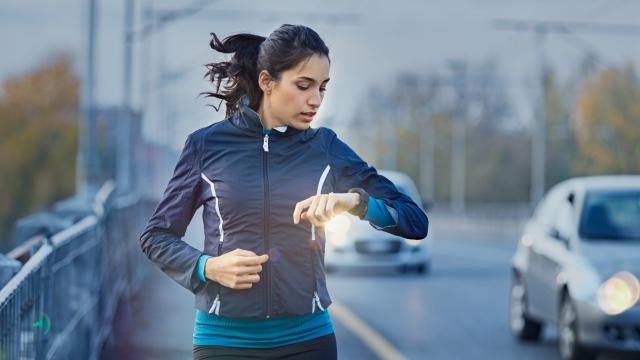With the news that the Apple Watch will soon be able to measure VO2max more effectively (they say) than ever, you may be wondering what VO2max even is. It’s a measure of your aerobic fitness, and you don’t need a gadget to figure yours out.
VO2max, properly rendered VO2max, is the maximal volume (V) of oxygen (O2) your body can use per minute during exercise, scaled to your body size because larger people will naturally use more oxygen.
This is considered a good measure of aerobic fitness because — think back to high school biology — your body uses oxygen and food to create a usable form of chemical energy. The amount of oxygen directly correlates with the amount of energy produced. Or, in simpler terms, the more work you do, the more oxygen you need.
So a person who is aerobically very fit — let’s say an elite marathon runner — can do more work (run faster) than somebody who isn’t. As a result, they’ll suck in a lot more oxygen per minute during their run than, say, I would.
A typical, sorta-fit human being will have a VO2max somewhere in the 30s or 40s. If you exercise a lot, you can push that number higher. Elite cyclists, skiers, and ultrarunners may have numbers in the 70s or 80s, and a few people out there have scored in the 90s.
Why is a high VO2max good?
To be able to use a large amount of oxygen, you need more than just good lungs. You also need a strong heart and healthy circulatory system to get the oxygen to your muscles. And you need muscles that are large and can do a lot of work per minute. VO2max is a way to summarize a lot of important things about cardio fitness into one simple number.
But it’s important to know that this number isn’t everything about fitness, or even aerobic fitness. First, it doesn’t make much sense to compare your VO2max to other people’s, because it’s affected by factors like blood volume and muscle mass. Men tend to have a VO2max about ten points higher than similarly fit women, for example. You also don’t usually know your exact VO2max anyway.
[referenced id=”1002716″ url=”https://www.lifehacker.com.au/2020/09/you-need-to-run-slower/” thumb=”https://www.gizmodo.com.au/wp-content/uploads/sites/4/2020/09/09/vy7uz3e0t1sqqqx3ynbi-300×169.png” title=”You Need to Run Slower” excerpt=”If running is hard, this is for you — especially if you’re a new runner, or if you’ve been running for a while but you just can’t seem to get any faster. The most important thing you need to learn is this: you get faster by running more, and you…”]
How can you measure your own VO2max?
The gold standard test is to exercise in a lab, breathing through a tube, where machines measure how much oxygen you are actually using. High-level athletes will sometimes take this test if they or their coach want to know their actual, definite VO2max number.
But we can measure aerobic fitness in other ways, and there are workouts you can do to get a good estimate of VO2max. If you’re a runner, you can look up a recent race time on this chart to find your VDOT, which roughly correlates with your VO2max. (My best-ever kilometre time gets me a VDOT of 38, for example.)
To estimate your VO2max from a workout, you need something that will take you to your absolute maximum aerobic output. A race does this job nicely; so will a test like running as many laps of a track as you can in 12 minutes. I recall doing a test in a Phys Ed. class once where we had to step up and down from a high box as many times as possible. These tests aren’t pleasant, but their results can be a benchmark to tell you whether you’re improving your fitness over time.
What does my watch tell me?
The Apple Health app has a VO2max estimate buried amongst the other fitness metrics, and it’s been there for years. (The new Watch software is supposed to improve this calculation.) Other fitness-tracking watches try to estimate this number as well. It seems like they usually use your running or walking speed, combined with your heart rate, to figure out how close you are to a maximal effort, and thus what your maximal pace would be.
As an example, Apple pegged my VO2max around 38 while I was training for a half marathon in the spring of 2019. The VDOT chart I linked earlier lists a value of 33-34 for my half marathon finish time of 2:08:28. I’ve never done a lab test, so I have no idea which is more accurate.
The VO2max you get from a fitness watch is an estimate of an estimate, so I wouldn’t put too much stock in the exact number you see. But if your VO2max seems to be consistently trending upward as you train, there’s a good chance you’re getting more fit. You would have noticed that on your own, though, because you’re either running faster or you’re able to run the same pace with less effort.

Leave a Reply
You must be logged in to post a comment.